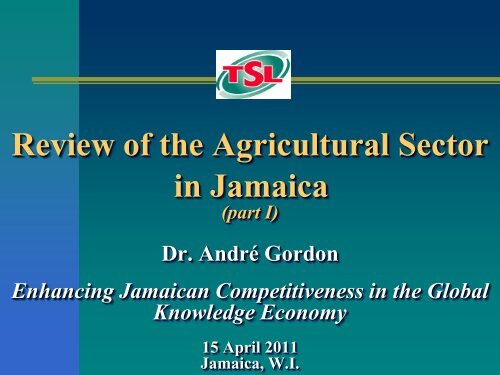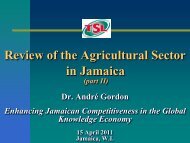Review Of The Agricultural Sector In Jamaica - Knowledge Society ...
Review Of The Agricultural Sector In Jamaica - Knowledge Society ...
Review Of The Agricultural Sector In Jamaica - Knowledge Society ...
You also want an ePaper? Increase the reach of your titles
YUMPU automatically turns print PDFs into web optimized ePapers that Google loves.
<strong>Review</strong> of the <strong>Agricultural</strong> <strong>Sector</strong><br />
in <strong>Jamaica</strong><br />
(part I)<br />
Dr. André Gordon<br />
Enhancing <strong>Jamaica</strong>n Competitiveness in the Global<br />
<strong>Knowledge</strong> Economy<br />
15 April 2011<br />
<strong>Jamaica</strong>, W.I.
<strong>In</strong>troduction
<strong>In</strong>troduction<br />
• Most developing countries depend on domestic<br />
agricultural production to meet a variety of<br />
National needs. <strong>The</strong>se include:<br />
– Food security<br />
– Earning foreign exchange from exports<br />
– Preventing rural urban drift<br />
– Protecting the environment<br />
– Developing, where possible, local value-added<br />
production
<strong>In</strong>troduction<br />
• <strong>Jamaica</strong> is no different in this regard.<br />
• <strong>The</strong> dynamics of production, trade, demand for<br />
food and energy and, consequently, their impact<br />
on food security, the safety of our domestic<br />
food supply, our ability to be able to afford to<br />
the imported component of our national food<br />
supply needs and to compete in the markets<br />
from which we seek to earn foreign exchange is<br />
rapidly changing.
<strong>In</strong>troduction<br />
• Unlike many developing countries, <strong>Jamaica</strong> has a<br />
relatively well developed and diverse agricultural<br />
and agro-industrial sector.
<strong>In</strong>tegrated Agribusiness Operations
<strong>In</strong>troduction<br />
• <strong>The</strong> current economic situation in <strong>Jamaica</strong>,<br />
combined with the clear and present<br />
danger presented by the inevitable and<br />
unceasing rise in the global demand for<br />
food and fuel (bio-fuels) make a strong,<br />
vibrant and competitive agricultural sector<br />
a critical component of <strong>Jamaica</strong>’s economic<br />
future.
<strong>In</strong>troduction<br />
• <strong>In</strong> this context, this review will examine our<br />
past agricultural policies and the outcomes<br />
of those policies, where we are today, and<br />
where we need to go in the future in the<br />
context of the <strong>Knowledge</strong> Economy of which<br />
we are a part.
<strong>Review</strong> of <strong>Jamaica</strong>’s<br />
<strong>Agricultural</strong> Policies<br />
1990 - 2005
<strong>Agricultural</strong> Policies 1995-2005<br />
• <strong>Jamaica</strong>’s agricultural policies in the mid<br />
1990 focused on the retention of preferences<br />
for traditional crops while seeking to<br />
encourage diversification<br />
• However, because agriculture was not seen<br />
as a major engine of economic growth, it<br />
was de-emphasized.
<strong>Agricultural</strong> Policies 1995-2005<br />
• This changed somewhat in the post-2004<br />
(Hurricane Ivan) period when new<br />
strategies were put in place.<br />
• <strong>The</strong>se policies and strategies are quite<br />
similar to the ones being pursued today, the<br />
major difference being the specific focus<br />
and detail of the sector strategies.
Strategies for Selected Crops: Citrus<br />
<strong>The</strong> following strategies were highlighted in the Medium-<br />
Term Plan<br />
1. Implementation of a National Citrus Certification<br />
Programme through the <strong>Jamaica</strong> Citrus Producers<br />
Association (JCPA) in conjunction with the National<br />
Citrus Council and with technical assistance from the FAO<br />
2. Enactment of legislation to make certification of planting<br />
materials mandatory for all citrus nurseries<br />
3. A citrus replanting project to reduce the negative impact of<br />
the Citrus Trestiza Virus (CTV) on citrus trees islandwide.
Strategies for Selected Crops: Bananas<br />
1. Concentration of production on more efficient farms (large<br />
farms comprising approximately 4000 acres and small<br />
farms about 3600 acres)<br />
2. Adoption of cost reduction measures at all stages of<br />
production and marketing<br />
3. Concentration of production on more productive lands<br />
4. Provision of technical and financial support in the areas of<br />
extension, irrigation, drainage and critical inputs<br />
5. Establishment of an efficient quality assurance<br />
programme<br />
6. Restructuring of the Banana <strong>In</strong>surance Scheme<br />
7. Rationalization of agencies managing the industry.
Strategies for Selected Crops: Coffee<br />
<strong>The</strong> Revitalization Plan for the Coffee <strong>In</strong>dustry called for the<br />
following:<br />
1. Sweeping changes in the areas of licensing and<br />
deregulation, marketing, pricing, financing and<br />
management of the industry<br />
2. Streamlining of procurement, drying and finishing<br />
3. <strong>In</strong>itiatives including appointment of a new board to<br />
address:<br />
– Improved quality control,<br />
– Separation and strengthening of the regulatory and commercial aspects,<br />
– Rationalization of the collection and processing functions, and<br />
– Divestment of coffee farms owned by the Board.
Conclusions<br />
• “<strong>The</strong> current policy measures may be<br />
deemed non-specific for the RTP<br />
commodities. This lack of specificity carries<br />
the danger of preventing the targeted<br />
commodities from achieving their potential.<br />
We therefore recommend that further<br />
refinement and detailing of the policies as<br />
articulated for banana and sugar be<br />
formatted for the RTP commodities of<br />
interest.
<strong>Review</strong> of <strong>Jamaica</strong>’s Current<br />
<strong>Agricultural</strong> Policy
Issues and Challenges Identified<br />
in our Current <strong>Agricultural</strong> Policy<br />
• Declining competitiveness<br />
– Small size of landholdings<br />
– High input costs<br />
– Limited application of modern technology<br />
• Limited staff and resources – extension<br />
services<br />
• Threats to sustainable use of forestry<br />
resources
Issues and Challenges Identified<br />
in our Current <strong>Agricultural</strong> Policy<br />
• Gaps in key infrastructure<br />
– <strong>In</strong>adequate feeder roads/maintenance<br />
– <strong>In</strong>adequate irrigation<br />
– Lack of grading sorting and packing facilities<br />
– Weak food safety infrastructure, including<br />
traceability<br />
• Aging work force<br />
• Loss of agricultural land to housing<br />
development
Issues and Challenges Identified<br />
in our Current <strong>Agricultural</strong> Policy<br />
• Weakness in marketing<br />
– Limited market information services<br />
– Weak linkages to other economic sectors<br />
– <strong>In</strong>formal marketing & distribution channels<br />
• Environmental issues<br />
– Soil erosion<br />
– Overuse of chemical fertilizers<br />
– Natural hazards<br />
– Monculture<br />
– deforestation
Issues and Challenges Identified<br />
in our Current <strong>Agricultural</strong> Policy<br />
• Threats to <strong>Jamaica</strong>’s marine fisheries<br />
– Over-harvesting<br />
– Habitat destruction<br />
– Poaching
<strong>Jamaica</strong>’s Current <strong>Agricultural</strong> Policy:<br />
<strong>The</strong> <strong>Agricultural</strong> Development Strategy<br />
• Contribution to Sustainable Growth &<br />
Development through<br />
– Employment creation<br />
– <strong>In</strong>creased export earnings*<br />
– Food security<br />
• Stabilization<br />
– halt current sustained decline in agriculture*<br />
• Rehabilitation – restoring lost productivity*
<strong>Jamaica</strong>’s Current <strong>Agricultural</strong> Policy:<br />
<strong>The</strong> <strong>Agricultural</strong> Development Strategy<br />
• Development of Agro-industry<br />
– Promote the development of sustainable<br />
linkages between agriculture and<br />
manufacturing*<br />
• Expansion of Products<br />
– increase production of select crops and<br />
livestock through productivity/efficiency<br />
increases,<br />
• Youth in Agriculture – increase participation
<strong>Jamaica</strong>’s Current <strong>Agricultural</strong> Policy:<br />
<strong>The</strong> <strong>Agricultural</strong> Development Strategy<br />
• Promote integrated rural development<br />
– Meaningful livelihood for farmers<br />
– Reduce rural/urban drift<br />
–Reduce poverty in rural areas<br />
– Sustainable agriculture
Selected <strong>Sector</strong> Strategies<br />
• Competitive Diversified Value-added Production<br />
– Strengthen <strong>Agricultural</strong> Research <strong>In</strong>stitutions<br />
– Develop a diversified range of agricultural products<br />
– Develop modern efficient farming<br />
– Implement development plans for key sub-sectors<br />
• Marketing for Domestic and Export Markets<br />
– Strengthen agricultural marketing structures<br />
– Strengthen linkages with manufacturing, tourism, others
Selected <strong>Sector</strong> Strategies<br />
• Human Resources<br />
– Establish model demonstration farms at<br />
strategic locations<br />
– Strengthen existing educational institutions<br />
– Encourage the participation of youth in<br />
agriculture<br />
• Environmental Sustainability<br />
– <strong>In</strong>crease use of best practices<br />
– Promote zero waste agriculture and processing<br />
• National Food Security<br />
– Promote national food security
Selected <strong>Sector</strong> Strategies<br />
• Enabling Framework, <strong>In</strong>frastructure &<br />
Support Service<br />
– Develop new sector policy<br />
– Promote micro-financing<br />
– Strengthen the capacity of MOAF to play<br />
supporting role<br />
– <strong>In</strong>crease number and capacity of extension<br />
officers<br />
– Address road network; praedial larceny<br />
– Address water supply and irrigation challenges<br />
– Strengthen farmer organizations
<strong>Jamaica</strong>’s <strong>Agricultural</strong><br />
Performance:<br />
What the Data Show
Value of <strong>Agricultural</strong> Exports 2003 – 2007 (US$’000)<br />
Jan-Nov Jan-Nov % Change<br />
Traditionals 2003 2004 2005 2006 2006 2007 p 2007/<br />
2006<br />
Bananas 18 844 12 814 4 692 13 412 12 402 9 222 -25.6<br />
Citrus (Fresh<br />
Fruit)<br />
3 160 2 057 1 480 986 813 1 606 97.5<br />
Coffee 28 919 38 683 16 334 29 649 28 744 24 891 -13.4<br />
Cocoa 2 245 910 318 1 002 673 1 976 193.6<br />
Pimento 2 764 2 164 2 856 1 410 1 410 2 077 47.3<br />
Total 55 932 56 628 25 680 46 459 44 042 39 772 -9.7<br />
p - Preliminary<br />
Source:<br />
Statistical<br />
<strong>In</strong>stitute of<br />
<strong>Jamaica</strong>
Age Distribution of <strong>Jamaica</strong>n Farmers<br />
Groups Reporting Young (< 35) Middle Age<br />
(35-55)<br />
Mature (>55)<br />
<strong>Jamaica</strong> 49,215 10,419 19,341 19,455<br />
Landless 6,966 2,416 3,017 1,533<br />
Small 41,578 7,955 16,092 17,531<br />
Medium 631 45 220 366<br />
Large 40 3 12 25<br />
Percentage<br />
<strong>Jamaica</strong> 100 21.17 39.30 39.53<br />
Landless 14.15 4.91 6.13 3.11<br />
Small 84.18 16.16 32.70 35.62<br />
Medium 1.28 0.09 0.45 0.74<br />
Large 0.08 0.01 0.02 0.05<br />
Source: Douglas, 2005 (calculated from <strong>Agricultural</strong> Census, 1996)
Characteristics of the <strong>Jamaica</strong>n<br />
Farmer, 2002<br />
• 36.03% below the age of 30<br />
• 37.38% between the ages of 31 and 49<br />
• 73.41% are now below the age of 50<br />
• Only 26.59% are older than 50<br />
• TODAY??<br />
Data from Gordon, 2010 – An analysis of the SLC and Labour Force<br />
Survey data
Export Value (US$) of Traditional Crops<br />
60000<br />
2003 – 2007 (US$)<br />
50000<br />
40000<br />
30000<br />
20000<br />
2003<br />
2004<br />
2005<br />
2006<br />
2006<br />
2007p<br />
10000<br />
0<br />
Bananas<br />
Citrus (Fresh<br />
Fruit)<br />
Coffee Cocoa Pimento Total
Export of Selected Traditional Products (2006-<br />
2010)<br />
50,000<br />
Traditional Commodities<br />
45,000<br />
40,000<br />
35,000<br />
US$'000<br />
30,000<br />
25,000<br />
20,000<br />
15,000<br />
10,000<br />
5,000<br />
0<br />
Jan. - Dec.<br />
2006<br />
Jan. - Dec.<br />
2007<br />
Jan. - Dec.<br />
2008<br />
Jan. - Dec.<br />
2009<br />
Jan. - Dec.<br />
2010<br />
Coffee (Agriculture / Fresh Beans) 28,744 24,891 22,647 33,652 19,157<br />
Rum 39,317 42,225 39,931 44,456 45,232<br />
Coffee Products (Manufacture) 2,311 4,487 1,143 1,368 2,426
<strong>Jamaica</strong>’s Non-Traditional Food Exports<br />
2009-2010(US$)<br />
US$'000<br />
COMMODITIES<br />
Jan – Dec Jan – Dec % % DIFFERENCE<br />
2010 2009 CHANGE<br />
FOOD 124,203 119,138 4.25 100.0% 5,065<br />
Dasheen 1,557 1,392 11.85 1.3% 165<br />
Sweet Potato 3,518 2,515 39.89 2.8% 1,003<br />
Yams 19,083 18,718 1.95 15.4% 366<br />
Papayas 2,780 2,867 -3.02 2.2% -87<br />
Ackee 12,753 13,558 -5.94 10.3% -805<br />
Other fruits and fruit<br />
6,694 6,242 7.25 5.4% 452<br />
preparations<br />
Meat and Meat Preparations 2,661 2,830 -5.95 2.1% -168<br />
Dairy Products and Bird's Eggs 6,150 6,509 -5.51 5.0% -359<br />
Fish, Crustaceans & Molluscs 7,973 4,738 68.28 6.4% 3,235<br />
Baked Products 11,893 10,788 10.24 9.6% 1,105<br />
Juices excluding Citrus 7,308 6,802 7.43 5.9% 506<br />
Sauces 11,063 10,556 4.80 8.9% 507<br />
Other Food Exports 18,821 19,893 -5.39 15.2% -1,072<br />
<strong>Jamaica</strong> Exporters' Association, April 2011
<strong>Jamaica</strong>n Production of Legumes (1998 – 2007)<br />
8000<br />
7000<br />
6000<br />
5000<br />
4000<br />
3000<br />
2000<br />
BROAD BEANS<br />
SUGAR BEANS<br />
COW PEA<br />
GUNGO PEA<br />
RED PEA<br />
PEANUT<br />
LEGUMES<br />
1000<br />
0<br />
1998 1999 2000 2001 2002 2003 2004 2005 2006 2007
Focus on Building Sustainable<br />
Global Competitiveness
Global Competitiveness<br />
• Developing the capacity and systems to<br />
deliver goods and services as, when and<br />
where needed in the desired quantity and at<br />
the expected level of quality to discerning<br />
consumers willing to pay a price for them<br />
that is profitable for the business (premium<br />
price, preferably).
How?<br />
• Developing and applying world-class<br />
technology in a practical, hands-on manner<br />
that is respectful of the culture of the<br />
people, organizations and countries<br />
involved
Six Components of Successful<br />
Export Activity<br />
•Market Expansion and Diversification<br />
•Production & Technology<br />
•Product <strong>In</strong>novation<br />
•Supply of <strong>In</strong>puts (Supply Chain Mgmt)<br />
•Financing<br />
•<strong>In</strong>formation Generation, access and use
Targeted Marketing of<br />
Export Products
Exporting Food from the<br />
<strong>Jamaica</strong> to the World<br />
• <strong>Jamaica</strong>n firms have been exporting<br />
world-class products to global markets<br />
for years<br />
• Many of these products are very well<br />
known and very successful
Potential Markets for <strong>Jamaica</strong>n/Caribbean<br />
Exports in New York<br />
CITY<br />
Total<br />
Population<br />
Total Population of<br />
<strong>Jamaica</strong>ns/West<br />
<strong>In</strong>dians (inc.<br />
African<br />
Americans)<br />
% of Total<br />
Population –<br />
<strong>Jamaica</strong>/<br />
West <strong>In</strong>dian<br />
Bronx 1,332,650 475,007 35.64<br />
Brooklyn 2,465,326 898,350 36.44<br />
Manhattan 1,537,195 267,302 17.39<br />
New York City 8,008,278 2,129,762 26.59<br />
Queens Borough 2,229, 379 446,189 20.01<br />
Buffalo 292,648 108,951 37.23<br />
Mount Vernon 68,381 40,743 59.58
Fastest Growing <strong>Sector</strong>s, in<br />
OECD Trade<br />
• Medicinal and Pharmaceutical Products<br />
• Cosmetics & Perfumery<br />
• Foods<br />
• Non-Alcoholic Beverages
Source: Lincoln Pryce,<br />
CRNM, 2006<br />
<strong>Jamaica</strong>-EU profile<br />
Dynamic Sales<br />
• Processed vegetables<br />
(49%)<br />
• Coffee (32%)<br />
• Non-alcoholic bev (33%)<br />
• Bread/pastries (24%)<br />
• Soups/broths (24%)<br />
• Processed fruits (36%)<br />
Declining Sales<br />
• Bananas (-16%)<br />
• Peppers (-17%)<br />
• Citrus fruit (-17%)<br />
• Cocoa beans (-8%)<br />
• Fresh fruit (-23%)<br />
• Unfermented<br />
Fruit/vegetable juice (-7)




